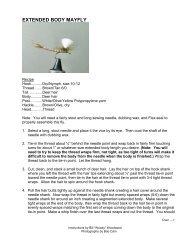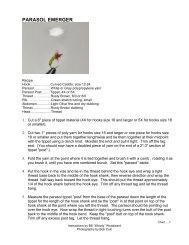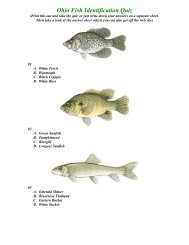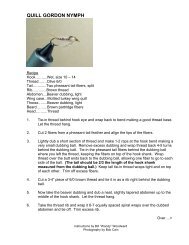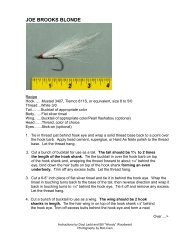Create successful ePaper yourself
Turn your PDF publications into a flip-book with our unique Google optimized e-Paper software.
<strong>WATERWISP</strong> <strong>LIGHT</strong> <strong>CAHILL</strong>RecipeHook!!.Waterwisp, size 12-14Thread!..Beige, yellow, cream, or tan 6/0Tail!!....Cream or Ginger hackle fibersBody!!..Cream rabbit or Fine and Dry dubbingHackle!...Cream or ginger dryWing!!..Bleached deer hair1. Place the hook in the vise by its eye and angled so that the bend is pointingstraight up with the point to the right.2. Tie-in the thread in the middle of the hook bend and wrap a short thread basedown the hook shank toward the hook eye, then wrap the thread back to themiddle of the hook bend. (You may wish to apply some cement to the threadat this time to ensure that it does not spin on the hook shank.) Trim off thethread tag and let the thread hang.3. Cut, clean, and stack a small bunch of deer hair to use as a wing and tie it in ontop of the hook shank at the middle of the hook bend with the hair tips pointingstraight out to the right. (The wing should be approximately the length of thehook shank.) Do not let the hair spin around the hook shank. Keeping thehair butts on top of the outside of the hook shank, wrap over them with tightthread wraps back to the beginning of the hook bend. Trim off any excess hairbutts and return the thread to the wing tie-in point in the middle of the hook bend.4. Select a hackle feather with barbs equal to 1 1/2 times the width of the hook gap.Strip off any fluff and tie it in by the butt at the same point as the wing. The dull(concave) side of the feather should face toward the hook shank. The length ofthe feather should extend to the right similarly to the wing. Keeping the featherbutt on the outside of the hook shank, wrap tight thread wraps over it to themiddle of the hook shank. Trim off any excess feather butt, then continuewrapping the thread to behind the hook. Let the thread hang.5. Now reposition the hook in the vise by the hook eye so that the hook point is upand the hook shank extends straight out to the right.Over!.>Instructions by Bill “Woody” WoodwardPhotography by Bob Cain
6. Strip off a bunch of hackle barbs and even the tips, then tie them in as a tail rightbehind the hook eye. (The tail should be one hook gap in length.) The tailtips should extend forward over the hook eye. Wrap thread over the tail buttsback to the end of the wing butts, then remove any excess butts and return thethread to the tail tie-in point behind the hook eye.7. Lightly dub the thread and wrap it up the hook shank to slightly below the wing,forming a neat body, then tie it off. Remove any excess dubbing and move thethread to a point 4-5 wraps below the wing tie-in point. (You may wish to do ahalf hitch at this point to keep the thread from sliding back down the hook bend.)8. Now take the hackle feather and, holding it with the dull side down, wrap itparachute style down the hook bend for 4-5 wraps and tie it off. (You may wishto stroke the fibers upward with each wrap to help avoid tying down fibersfrom the previous wrap.) Remove any excess hackle and do a horizontalwhip finish where you tied off the hackle in the middle of the hook bend. Cut thethread. You're done.Note: The Waterwisp style of tying (that is tying a fly in reverse) is adaptable to manystandard dry fly patterns and is greatly facilitated by the waterwisp hook, which isproprietary. The hooks can be obtained at www.waterwisp.com.Instructions by Bill “Woody” WoodwardPhotography by Bob Cain



